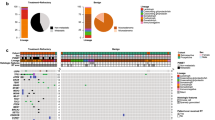Abstract
Background
Pheochromocytoma and paraganglioma (PPGL) are rare neuroendocrine tumours, often associated with germline mutations that influence the disease biology and clinical course. We aimed to describe the genotypic and phenotypic characteristics of a consecutive series of PPGL patients and correlate mutation status with clinical outcomes.
Methods
We performed a retrospective cohort study of all PPGL patients who presented to a tertiary referral centre between March 2005 and February 2022. Genotypic, phenotypic and follow-up data were analysed.
Results
A total of 140 patients were included. Of these, 94 (67%) patients underwent genetic testing and a mutation was detected in 36 (38%) patients. Mutation presence was associated with younger age, smaller tumour size and bilateral adrenal tumours. Disease recurrence occurred at a median time of 5.4 (IQR 2.8–11.0) years after treatment in 21 (15%) patients, of which 14 (67%) had a mutation in a susceptibility gene. Recurrence pattern was influenced by mutation type; higher local recurrence risk for SDHA, SDHB, and MEN2B disease, and higher metastatic risk for SDHB, VHL and MEN2A disease. Recurrence occurred in three (3%) patients with mutation absence. Multivariate analysis revealed that age ≤40 years and mutation presence were associated with increased risk of disease recurrence.
Conclusions
Genotypic characteristics strongly influence disease presentation and recurrence risk, which may occur more than 5 years after initial treatment. Routine genetic testing of PPGL patients is warranted given the high prevalence of mutations, allowing for prognostication and tailored follow-up. In the presence of germline mutations, follow-up should be life-long.
Graphical abstract


Similar content being viewed by others
References
Mete O, Asa SL, Gill AJ et al (2022) Overview of the 2022 WHO classification of paragangliomas and pheochromocytomas. Endocr Pathol 33:90–114
Dahia PLM (2014) Pheochromocytoma and paraganglioma pathogenesis: learning from genetic heterogeneity. Nat Rev Cancer 14:108–119
Neumann HPH, Young WF, Eng C (2019) Pheochromocytoma and paraganglioma. NEJM 381:552–565
Lenders JWM, Duh Q-Y, Eisenhofer G et al (2014) Pheochromocytoma and paraganglioma: an endocrine society clinical practice guideline. J Clin Endocr 99:1915–1942
Favier J, Amar L, Gimenez-Roqueplo AP (2015) Paraganglioma and phaeochromocytoma: from genetics to personalized medicine. Nat Rev Endocrinol 11:101–111
Kim JH, Kim MJ, Kong SH et al (2022) Characteristics of germline mutations in Korean patients with pheochromocytoma/paraganglioma. J Med Genet 59:56–64
Liu Z, Ma J, Jimenez C et al (2021) Pheochromocytoma: a clinicopathologic and molecular study of 390 cases from a single center. Am J Surg Pathol 45:1155–1165
Fishbein L, Del Rivero J, Else T et al (2021) The North American neuroendocrine tumor society consensus guidelines for surveillance and management of metastatic and/or unresectable pheochromocytoma and paraganglioma. Pancreas 50:469–493
Plouin PF, Amar L, Dekkers OM et al (2016) European Society of Endocrinology Clinical Practice Guideline for long-term follow-up of patients operated on for a phaeochromocytoma or a paraganglioma. Eur J Endocrinol 174:G1–G10
Amar L, Bertherat J, Baudin E et al (2005) Genetic testing in pheochromocytoma or functional paraganglioma. J Clin Oncol 23:8812–8818
Press D, Akyuz M, Dural C et al (2014) Predictors of recurrence in pheochromocytoma. Surgery 156:1523–1527
Amar L, Servais A, Gimenez-Roqueplo A-P et al (2005) Year of diagnosis, features at presentation, and risk of recurrence in Patients with pheochromocytoma or secreting paraganglioma. J Clin Endocr 90:2110–2116
Gomella PT, Sanford TH, Pinto PA et al (2020) Long-term Functional and oncologic outcomes of partial adrenalectomy for pheochromocytoma. Urology 140:85–90
Dhir M, Li W, Hogg ME et al (2017) Clinical predictors of malignancy in patients with pheochromocytoma and paraganglioma. Ann Surg Oncol 24:3624–3630
Amar L, Baudin E, Burnichon N et al (2007) Succinate dehydrogenase B gene mutations predict survival in patients with malignant pheochromocytomas or paragangliomas. J Clin Endocr 92:3822–3828
Assadipour Y, Sadowski SM, Alimchandani M et al (2017) SDHB mutation status and tumor size but not tumor grade are important predictors of clinical outcome in pheochromocytoma and abdominal paraganglioma. Surgery 161:230–239
Parasiliti-Caprino M, Lucatello B, Lopez C et al (2020) Predictors of recurrence of pheochromocytoma and paraganglioma: a multicenter study in Piedmont, Italy. Hypertens Res 43:500–510
Thompson LDR (2002) Pheochromocytoma of the adrenal gland scaled score (pass) to separate benign from malignant neoplasms: a clinicopathologic and immunophenotypic study of 100 Cases. Am J Surg Pathol 26:551–566
Wu D, Tischler AS, Lloyd RV et al (2009) Observer variation in the application of the pheochromocytoma of the adrenal gland scaled score. Am J Surg Pathol 33:599–608
Author information
Authors and Affiliations
Corresponding author
Ethics declarations
Conflict of interest
The authors declare that they have no conflict of interest.
Additional information
Publisher's Note
Springer Nature remains neutral with regard to jurisdictional claims in published maps and institutional affiliations.
Rights and permissions
Springer Nature or its licensor (e.g. a society or other partner) holds exclusive rights to this article under a publishing agreement with the author(s) or other rightsholder(s); author self-archiving of the accepted manuscript version of this article is solely governed by the terms of such publishing agreement and applicable law.
About this article
Cite this article
Wang, H., Papachristos, A.J., Gill, A.J. et al. Genotype–Phenotype Correlations and Clinical Outcomes in 155 Cases of Pheochromocytoma and Paraganglioma. World J Surg 47, 690–698 (2023). https://doi.org/10.1007/s00268-022-06862-w
Accepted:
Published:
Issue Date:
DOI: https://doi.org/10.1007/s00268-022-06862-w




